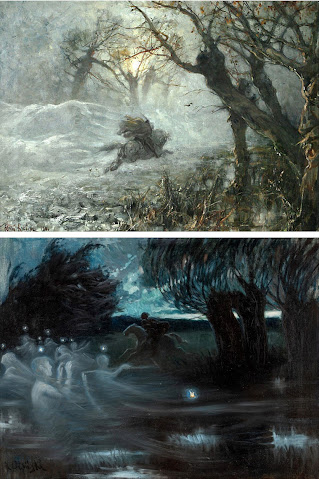It’s time again for a fantasy poem, and today I’ve picked one that I think of as wintry, with its cold winds, dry leaves, and rising mists. This is an English translation (by Edgar Alfred Bowring) of the very famous German poem written in 1782 by Johann Wolfgang von Goethe (Germany, 1749-1832). Goethe’s version was inspired by a traditional Danish ballad. I’ve changed the punctuation and formatting slightly because there are three characters with speaking roles and it can be a little hard to tell who’s talking when. I’ve put the father and son simply in quotation marks, while the Erlking is also in italics.
Who rides there so late through the night dark and drear?
The father it is, with his infant so dear;
He holdeth the boy tightly clasp'd in his arm,
He holdeth him safely, he keepeth him warm.
Dost see not the Erl-King, with crown and with train?”
“My son, 'tis the mist rising over the plain.”
"Oh, come, thou dear infant! oh come thou with me!
For many a game, I will play there with thee;
On my strand, lovely flowers their blossoms unfold,
My mother shall grace thee with garments of gold."
“My father, my father, and dost thou not hear
The words that the Erl-King now breathes in mine ear?”
“Be calm, dearest child, 'tis thy fancy deceives;
'Tis the sad wind that sighs through the withering leaves.”
"Wilt go, then, dear infant, wilt go with me there?
My daughters shall tend thee with sisterly care;
My daughters by night their glad festival keep,
They'll dance thee, and rock thee, and sing thee to sleep."
“My father, my father, and dost thou not see,
How the Erl-King his daughters has brought here for me?”
“My darling, my darling, I see it aright,
'Tis the aged grey willows deceiving thy sight.”
"I love thee, I'm charm'd by thy beauty, dear boy!
And if thou'rt unwilling, then force I'll employ."
“My father, my father, he seizes me fast,
For sorely, the Erl-King has hurt me at last.”
The father now gallops, with terror half wild,
He grasps in his arms the poor shuddering child;
He reaches his courtyard with toil and with dread,
The child in his arms finds he motionless, dead.
There are a couple of interesting elements in this poem. For one thing, it wouldn’t have to be read as fantasy at all, since we’ve got an unreliable narrator. Some people argue that the son is delirious with illness, the father’s interpretations of natural phenomena are the truth, and there is no supernatural element at work. I, of course, prefer to read the son’s version as correct, while the father just can’t see it. And if that’s the case, the next interesting question is who or what the Erlking is. Many English translations use “Elfking,” and the original Danish ballad also features elves (specifically the Elven king’s daughter, rather than the king himself.) But the German “Erl” should really be translated “alder tree.” Some scholars theorize that the German was simply a mistranslation from the Danish, which is certainly always possible. But it also doesn’t seem implausible to me that the Alder King would be a powerful magical figure in folklore, and if so the name could have been chosen deliberately for the German translation. Alders are often associated with the faeries, as well as with secrecy and all manner of charms, both protective and dangerous.
Because of the fame and popularity of Goethe’s poem (including an English translation by Sir Walter Scott), not to mention the darkly dramatic combination of mystery and pathos, there are lots of illustrations. The ambiguity in the ballad gives artists plenty of creative leeway. Does the Erlking look like a skeleton representing death, or more like a tree, or just a mysterious mist? Is he hard and solid, or semi-transparent and ethereal, or perhaps there is no Erlking visible at all? Do you emphasize the creepy nighttime landscape, or the characters and their expressions? This isn’t a story I have any desire to illustrate, but I do appreciate the different ways these artists have approached the challenge. How would you do it?
Finally, if you wish to hear Goethe’s poem set to music by Franz Schubert and animated by Ben Zelkowicz, check out this short.
[Pictures: The Erl-King, etching and aquatint by Letterio Calapai, 1950 (Image from The Old Print Shop);
Fear, etching by Odilon Redon, 1866 (Image from The Met);
The Erlking, lithograph by Harry Brodsky, before 1982 (Image from Smithsonian);
Erlkönig, woodcut by Hans Knipert, first half 20th century (Image from Dallas Museum of Art);
The King of the Woods, painting by Juli von Klever, c. 1887 (Image from Heritage Images);
Król Olch, painting by Jan Kazimierz Olpinski, before 1936 (Image from Connaisseur Kraków).]




No comments:
Post a Comment